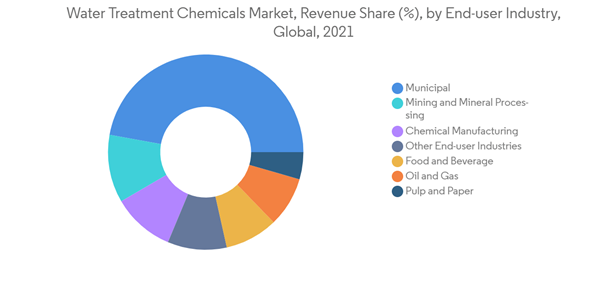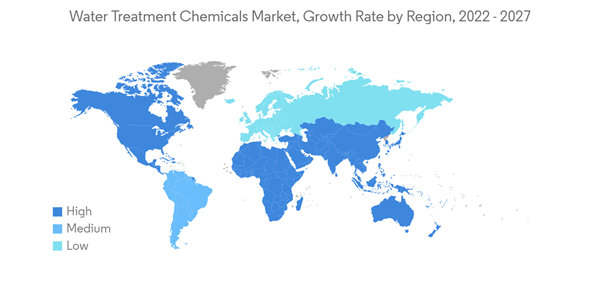The global water treatment chemicals market is estimated to be valued at USD 33,930.28 million in 2022 and is expected to register a CAGR of 6.53% between 2022 and 2027.
Due to the COVID 19 outbreak, the chemical sector has been affected negatively worldwide. The scarcity of resources, workforce shortages, and other constraints significantly hampered the industry's expansion. The market is expected to reach the pre-pandemic level in the forecast period.
The global market for water treatment chemicals is fragmented in nature. Some of the major players in the market include (in no particular order) Ecolab, Solenis, Suez, and Veolia, and SNF among others.
This product will be delivered within 2 business days.
Due to the COVID 19 outbreak, the chemical sector has been affected negatively worldwide. The scarcity of resources, workforce shortages, and other constraints significantly hampered the industry's expansion. The market is expected to reach the pre-pandemic level in the forecast period.
Key Highlights
- The rising ground and surface water pollution and stringent regulations about wastewater treatment are likely to drive the growth of the water treatment chemicals market.
- The stringent regulations pertaining to wastewater treatment are also expected to boost the market growth during the forecast period.
- On the flip side, the hazardous nature of hydrazine is expected to hinder the market's growth.
- Increasing focus on treating emerging contaminates is expected to unveil new opportunities for the market studied.
- Asia-Pacific is expected to dominate the market during the forecast period due to high demand from countries like China and India.
Key Market Trends
Municipal End-user Industry to Dominate the Market
- The supply of pure water to households is one of the chief requirements for all governments. The rising scarcity of potable water, coupled with the growing population and increasing water demand, is the primary concern driving the demand for the water treatment chemicals market.
- Municipal wastewater is the water drains from toilets, showers, sinks, bathrooms, washing machines, dishwashers, and liquid industrial waste. Municipal wastewater should be treated before releasing it into the environment to avoid damaging the environment and spreading harmful diseases.
- The water treatment industry is expected to register a healthy growth rate in Mexico. The country housed a large number of wastewater treatment plants. It has almost 2,477 municipal wastewater treatment plants, 2,639 wastewater treatment plants, 874 potable water treatment plants, and 435 desalination plants. Ongoing research in the country indicates the government to majorly focus on developing municipal wastewater treatment plants, mainly in the urban areas, which is likely to promote the demand for water treatment chemicals.
- In Germany, the increasing water treatment activities, primarily in the northern region, boost the demand for water treatment chemicals. Environmental protection and human health are considered extremely important in Germany. This importance has led to efficient water and wastewater treatment methods, and nearly 100% of the wastewater in Germany is treated to meet the highest standards set by the European Union.
- Therefore, the demand for wastewater treatment is expected to increase significantly in the upcoming forecast period.
Asia-Pacific to Dominate the Market
- Asia-Pacific dominated the water treatment chemicals market, owing to the high demand from countries like China and Japan.
- The rapid economic growth and urbanization in China are likely to drive the growth of several industries, like municipal, chemical, food and beverages, oil and gas, and power generation, which, in turn, is likely to boost the demand for water treatment chemicals.
- Moreover, most of China’s population relies on groundwater sources for drinking water, which are either untreated or not adequately treated by municipal water suppliers. Therefore, the need for water treatment chemicals increases.
- According to International Trade Administration, China plans to build or renovate 80,000 km of sewage collection pipeline networks and increase sewage treatment capacity by 20 million cubic meters/day between 2021 and 2025.
- In India, there has been an increase in chemical manufacturing plants. Additionally, the power generation sector in India is constantly evolving.
- In March 2021, the government informed that an investment of INR8 lakh crore is anticipated in the sector by 2025, with opportunities offered by the increase in demand by about 9% per annum over the next five years, with about 168 investment prospects and about 29 projects under development.
- According to the Indian Ministry of Power, for the year 2021-22, the energy generation target for thermal, hydro, nuclear, and Bhutan imports has been set at 1356 billion units, with an increase of 9.83 % as compared to the previous year's actual generation.
- Hence, Asia-Pacific will likely dominate the market studied during the forecast period.
Competitive Landscape
The global market for water treatment chemicals is fragmented in nature. Some of the major players in the market include (in no particular order) Ecolab, Solenis, Suez, and Veolia, and SNF among others.
Additional Benefits:
- The market estimate (ME) sheet in Excel format
- 3 months of analyst support
This product will be delivered within 2 business days.
Table of Contents
1 INTRODUCTION
4 MARKET DYNAMICS
5 MARKET SEGMENTATION
6 COMPETITIVE LANDSCAPE
7 MARKET OPPORTUNITIES AND FUTURE TRENDS
Companies Mentioned (Partial List)
A selection of companies mentioned in this report includes, but is not limited to:
- Aditya Birla Chemicals (India) Ltd.
- Albemarle Corporation
- BASF SE
- Buckman Laboratories Inc.
- Chemtrade
- ChemTreat Inc.
- Dow
- Ecolab
- Kemira
- Kurita Water Industries Ltd
- Nouryon
- SNF
- Solenis
- Solvay
- Suez
- USALCO
- Veolia
Methodology

LOADING...










